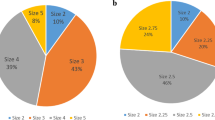Abstract
Introduction and hypothesis
The aim of this study was to investigate factors associated with long-term pessary use in patients with advanced pelvic organ prolapse (POP).
Methods
This was a retrospective chart review of patients with POP of stage ≥2 managed with a pessary. Patients were excluded if the date of fitting or follow-up was unavailable. Long-term use was defined as more than 1 year. Patient demographics, pessary fitting, and follow-up visit dates were collected. The primary end point was the duration of use and the prognostic impact of pessary type. Secondary objectives addressed other influencing factors including age, estrogen use, and prolapse stage. The data were analyzed using SPSS version 21.
Results
The final analysis included 311 patients. The mean (± standard deviation, SD) duration of pessary use was 7.0 ± 0.72 years (median 5.7 years). Long-term use was found in 76 % (164) of these patients. Factors associated with longer use were age >65 years (p = 0.004) and estrogen use (p = 0.048). The estimated mean (± SD) durations of use of the Gellhorn, open ring, ring with support, cube and donut pessaries were 10.5 ± 0.7 years, 3.4 ± 0.6 years, 1.8 ± 0.2 years, 1.8 ± 0.3 years and 1.7 ± 0.5 years, respectively. The Gellhorn pessary was associated with significantly longer use than other pessary types (10.5 ± 0.7, p < 0.0000001); this finding was independent of age, prolapse stage, hysterectomy, and vaginal estrogen use.
Conclusions
In this retrospective analysis, the duration of use was longest with the Gellhorn pessary. Older age and vaginal estrogen use were associated with longer pessary use.


Similar content being viewed by others
References
Swift SE. The distribution of pelvic organ support in a population of female subjects seen for routine gynecologic health care. Am J Obstet Gynecol. 2000;183(2):277–285. doi:10.1067/mob.2000.107583.
Olsen AL, Smith VJ, Bergstrom JO, Colling JC, Clark AL. Epidemiology of surgically managed pelvic organ prolapse and urinary incontinence. Obstet Gynecol. 1997;89(4):501–506. doi:10.1016/S0029-7844(97)00058-6.
Bai SW, Yoon BS, Kwon JY, Shin JS, Kim SK, Park KH. Survey of the characteristics and satisfaction degree of the patients using a pessary. Int Urogynecol J Pelvic Floor Dysfunct. 2005;16(3):182–186. doi:10.1007/s00192-004-1226-9. discussion 186.
Sarma S, Ying T, Moore KH. Long-term vaginal ring pessary use: discontinuation rates and adverse events. BJOG. 2009;116(13):1715–1721. doi:10.1111/j.1471-0528.2009.02380.x.
Braekken IH, Majida M, Engh ME, Bø K. Can pelvic floor muscle training reverse pelvic organ prolapse and reduce prolapse symptoms? An assessor-blinded, randomized, controlled trial. Am J Obstet Gynecol. 2010;203(2):170.e171–170.e177. doi:10.1016/j.ajog.2010.02.037.
Manchana T, Bunyavejchevin S. Impact on quality of life after ring pessary use for pelvic organ prolapse. Int Urogynecol J. 2012;23(7):873–877. doi:10.1007/s00192-011-1634-6.
Hanson LA, Schulz JA, Flood CG, Cooley B, Tam F. Vaginal pessaries in managing women with pelvic organ prolapse and urinary incontinence: patient characteristics and factors contributing to success. Int Urogynecol J Pelvic Floor Dysfunct. 2006;17(2):155–159. doi:10.1007/s00192-005-1362-x.
Robert M, Schulz JA, Harvey MA, Urogynaecology Committee, et al. Technical update on pessary use. J Obstet Gynaecol Can. 2013;35(7):664–674.
Manchana T. Ring pessary for all pelvic organ prolapse. Arch Gynecol Obstet. 2011;284(2):391–395. doi:10.1007/s00404-010-1675-y.
Lone F, Thakar R, Sultan AH, Karamalis G. A 5-year prospective study of vaginal pessary use for pelvic organ prolapse. Int J Gynaecol Obstet. 2011;114(1):56–59. doi:10.1016/j.ijgo.2011.02.006.
Wang XQ, Zhu L, Li B, Tang X, Xu T. A prospective study of pessary treatment for pelvic organ prolapse and health-related quality-of-life. Zhonghua Yi Xue Za Zhi. 2013;93(37):2982–2985.
Fernando RJ, Thakar R, Sultan AH, Shah SM, Jones PW. Effect of vaginal pessaries on symptoms associated with pelvic organ prolapse. Obstet Gynecol. 2006;108(1):93–99. doi:10.1097/01.AOG.0000222903.38684.cc.
Friedman S, Sandhu KS, Wang C, Mikhail MS, Banks E. Factors influencing long-term pessary use. Int Urogynecol J. 2010;21(6):673–678. doi:10.1007/s00192-009-1080-x.
Clemons JL, Aguilar VC, Sokol ER, Jackson ND, Myers DL. Patient characteristics that are associated with continued pessary use versus surgery after 1 year. Am J Obstet Gynecol. 2004;191(1):159–164.
Brazell HD, Patel M, O’Sullivan DM, Mellen C, LaSala CA. The impact of pessary use on bowel symptoms: one-year outcomes. Female Pelvic Med Reconstr Surg. 2014;20(2):95–98. doi:10.1097/SPV.0000000000000060.
Geoffrion R, Zhang T, Lee T, Cundiff GW. Clinical characteristics associated with unsuccessful pessary fitting outcomes. Female Pelvic Med Reconstr Surg. 2013;19(6):339–345. doi:10.1097/SPV.0b013e3182a26174.
Clemons JL, Aguilar VC, Tillinghast TA, Jackson ND, Myers DL. Risk factors associated with an unsuccessful pessary fitting trial in women with pelvic organ prolapse. Am J Obstet Gynecol. 2004;190(2):345–350. doi:10.1016/j.ajog.2003.08.034.
Dessie SG, Armstrong K, Modest AM, Hacker MR, Hota LS. Effect of vaginal estrogen on pessary use. Int Urogynecol J. 2016;27(9):1423–1429. doi:10.1007/s00192-016-3000-1.
Abdool Z, Thakar R, Sultan AH, Oliver RS. Prospective evaluation of outcome of vaginal pessaries versus surgery in women with symptomatic pelvic organ prolapse. Int Urogynecol J. 2011;22(3):273–278. doi:10.1007/s00192-010-1340-9.
Cundiff GW, Amundsen CL, Bent AE, Coates KW, Schaffer JI, Strohbehn K, et al. The PESSRI study: symptom relief outcomes of a randomized crossover trial of the ring and Gellhorn pessaries. Am J Obstet Gynecol. 2007;196(4):405.e401–405.e408. doi:10.1016/j.ajog.2007.02.018.
Bugge C, Adams EJ, Gopinath D, Reid F. Pessaries (mechanical devices) for pelvic organ prolapse in women. Cochrane Database Syst Rev. 2013;(2), CD004010. doi:10.1002/14651858.CD004010.pub3.
Acknowledgements
The authors thank Cynthia Brincat of Loyola University Medical Center for support with project planning and completion.
Author information
Authors and Affiliations
Corresponding author
Ethics declarations
Conflicts of interest
None.
Rights and permissions
About this article
Cite this article
Wolff, B., Williams, K., Winkler, A. et al. Pessary types and discontinuation rates in patients with advanced pelvic organ prolapse. Int Urogynecol J 28, 993–997 (2017). https://doi.org/10.1007/s00192-016-3228-9
Received:
Accepted:
Published:
Issue Date:
DOI: https://doi.org/10.1007/s00192-016-3228-9




